Art × Science: Face Project
<Production Report No. 5 (final)> The Eyes Breathe Life into the Sculptures. The Sculptures of Audrey Hepburn Are Complete
This is an English translation of information in Japanese on December 18, 2020.
In May of 2019, Kao began working with the contemporary sculptor Kazu Hiro in a joint research project to sculpt and cast two ultra-realistic portraits of Audrey Hepburn at double her real-life size. Through the process, Kazu Hiro and Kao used artistic and scientific methods to explore the elements that make a human face radiant and unique.
This series focuses on the process Kazu Hiro used to bring his lifelike creations into being. This fifth and final report describes how he created the eyes, the most expressive part of his subject's face.
The oculi
Once the silicone face was colored and the hair of the head and face was at last in place, Kazu created Audrey Hepburn's famously expressive eyes.
To recreate the structure of the oculus as faithfully as possible, Kazu made three different parts separately—the sclera, the iris, and the lens —and assembled them into a whole. The delicate pattern and colors of the iris were rendered with an ultrafine brush. If Audrey Hepburn's irises had been blue or green, Kazu would have first applied blue or green as baseline colors. In fact her irises were somewhere between hazel and dark green.
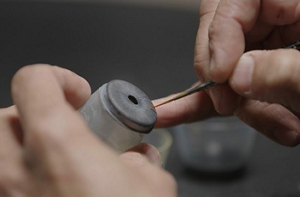
The pupil of an eye behaves like the aperture of a camera, dilating to take in more light in darker environments and contracting to filter out light when it's bright. Kazu made Audrey's pupils an average size, as when indoors in normal light.
Once the irises for the sculptures were finished, Kazu placed them together with the lenses into two molds for the sclera of the eyes, one for the left and one for the right. He then poured a white resin into the molds and allowed it to cure. Next came a baseline color and ultrafine streaks of red to depict the capillaries.
As a native of Kyoto, Kazu recognized that the fine threads of Kimono silk were a perfect stand-in for the ultrafine capillaries of an eye. The idea came to him when he received a red silken kimono as a gift from a kimono designer. Working with careful precision, he extricated several silk fibers, cut them into shorter strips, and glued them to the sclera of the eyes. As expected, the fibers looked more natural than ultrafine streaks of red pigment painted onto the silicone. He glued the capillary vessels over the sclera on every side, even on the surfaces that were to be hidden inside the head. By adding more vessels on the inner halves of the eyes, towards the center of the face, he enhanced the verisimilitude still further.

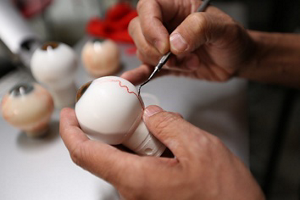
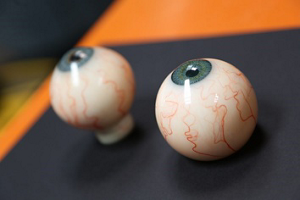
Depicting the age difference in the eyes
Finding reference images of the younger Audrey Hepburn's eyes was a challenge. Flash photography and black-and-white film were the norm for news photographs taken in the 1950s. Photographs showing the color of Audrey's eyes were rare. As a workaround, Kazu examined photographs of people with similarly colored eyes.
To show Audrey's age in the sculpture of her older self, Kazu added touches of yellow to the sclera of her eyes. Cloudy white rings, a condition scientists call 'arcus senilis,' often appear around the irises of an aging person. None appeared in Audrey's eyes, so none could be added to show her age.
The eyes breathe life into the sculptures
To Kazu Hiro, the eyes bring life to the faces he creates. "The eyes are the first thing we see in a person’s face. If the eyes of a sculpture portrait are the tiniest bit wonky, the likeness to the subject is lost."
When the four eyeballs were finished, Kazu carefully placed them into their sockets from behind, passing them in through small holes in the backs of the silicone heads, hidden under the hair.
Kazu spent a long time staring head-on at the two faces to determine the optimum angle of vision. He examined the face from various angles, sometimes up close, sometimes from a distance, and adjusted the positions of the eyes in millimeter degrees.
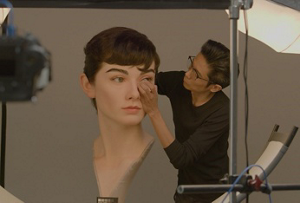
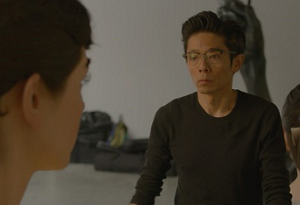
The angle of vision, he explained, depended upon the point of focus where Audrey's gaze was fixed. "There must be purpose behind the direction of the portrait's gaze, and the angle of vision must be balanced. If the eyes are even slightly askew, the portrait will look vacuous or hollow. In positioning Audrey's angle of vision, my goal was to make her eyes look purposeful. She came to life from the moment this effect was attained."
The completed sculptures of Audrey Hepburn
Kazu decided that the sculpted Audrey should incline her neck and direct her gaze to the left. Once the angle of vision was set, his next step was to draw lines with a diluted silicone solution beneath the eyelids, starting from the lachrymal glands, to depict a light veil of moisture. He arranged Audrey's hair as he would with a real person, taking her in as a whole.
The sculpture of the young Audrey depicts an innocent person who was hopeful and uncertain about the future. Audrey may have been just such a person when she made her Hollywood debut in Roman Holiday. The older sculpture shows a woman marked by painful childhood memories of the Second World War who devoted herself to the support of disadvantaged children as a UNICEF ambassador. The two sculptures were finally completed after six months of intensive work.
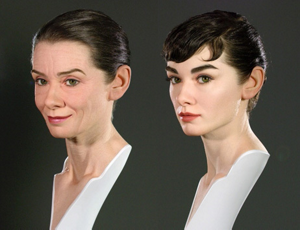
* This is not a realistic rendering of the subject but the artist's interpretation.

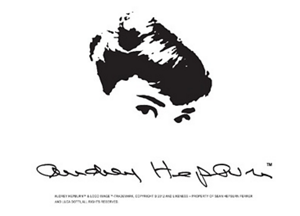
About Kao
Kao creates high-value-added products that enrich the lives of consumers around the world. Through its portfolio of over 20 leading brands such as Attack, Bioré, Goldwell, Jergens, John Frieda, Kanebo, Laurier, Merries and Molton Brown, Kao is part of the everyday lives of people in Asia, Oceania, North America and Europe. Combined with its chemical division, which contributes to a wide range of industries, Kao generates about 1,500 billion yen in annual sales. Kao employs about 33,000 people worldwide and has 130 years of history in innovation. Please visit the Kao Group website for updated information.
Media inquiries should be directed to:
Corporate Communications
Kao Corporation
